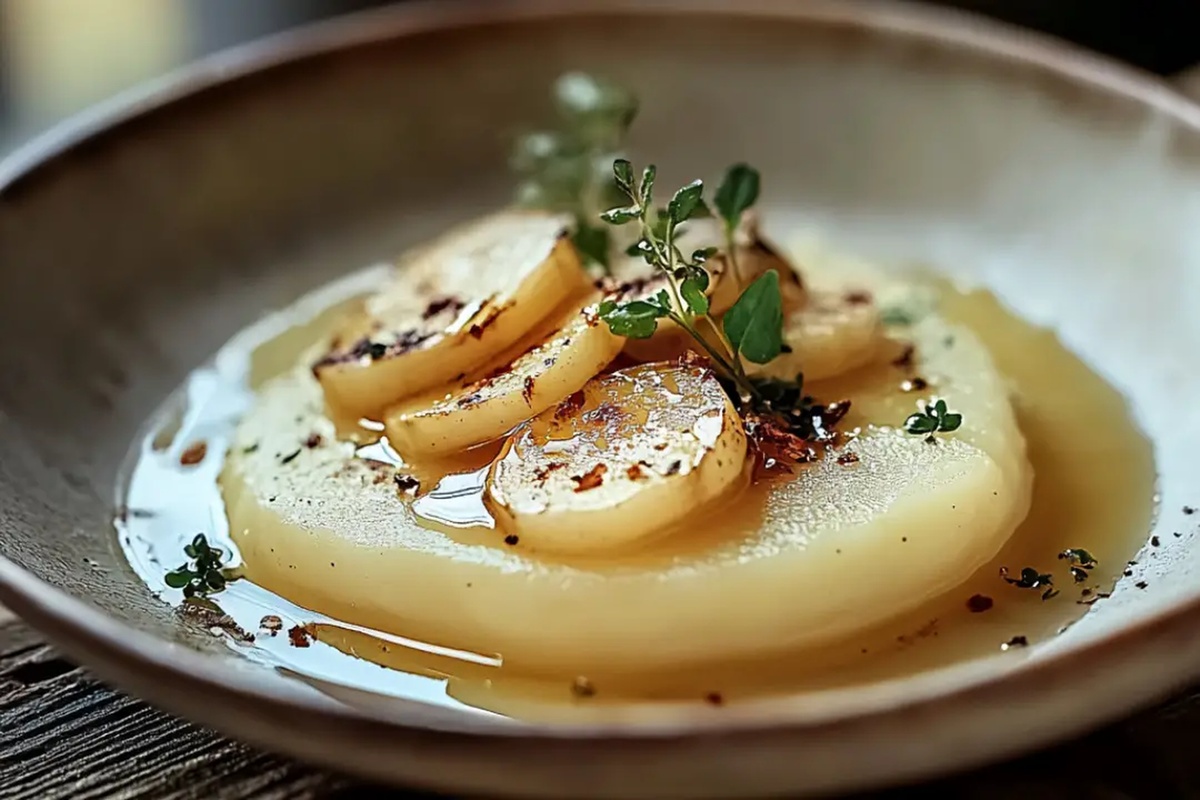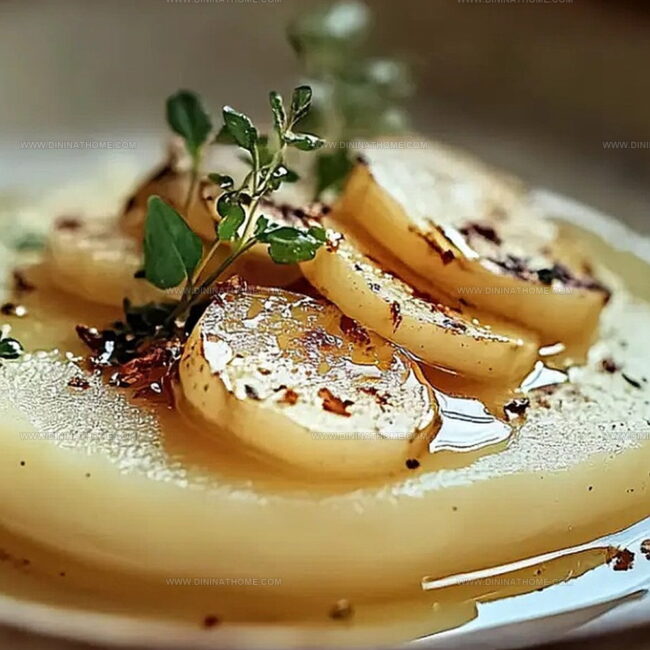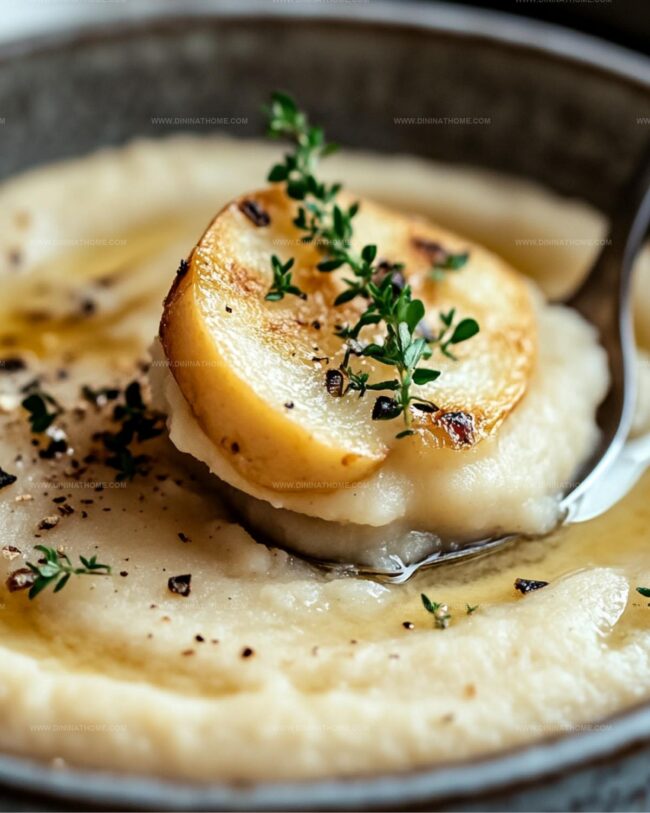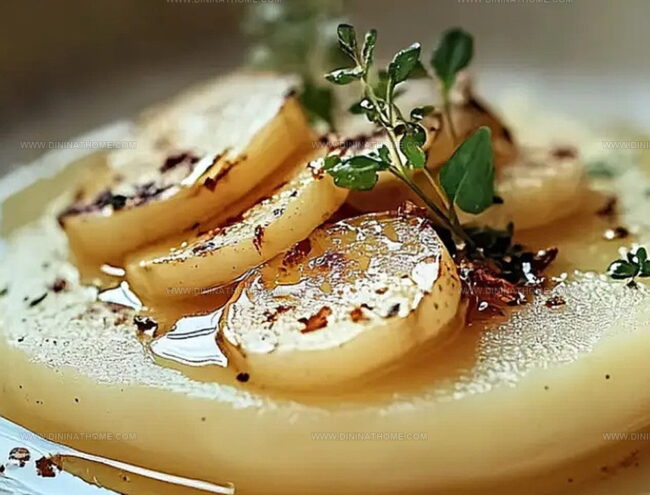Silky Smooth Parsnip Puree Recipe: A Cozy Side Dish Delight
Cold winter nights call for a silky parsnip puree that whispers comfort directly onto your plate.
Creamy textures blend seamlessly with subtle earthy undertones in this elegant side dish.
Root vegetables often hide surprising depth of flavor waiting to be discovered.
Smooth and velvety, this puree offers a gentle alternative to standard mashed potatoes.
Simple ingredients create magical moments around the dinner table.
Minimal effort produces maximum satisfaction with each delightful spoonful.
What Makes Parsnip Puree Smooth and Subtle
Parsnip Puree – Ingredient Checklist
Main Vegetables:Flavor Enhancers:Fat and Seasoning:Smooth Parsnip Puree in a Few Easy Steps
Step 1: Boil Vegetables Perfectly
Fill a large pot with water and sprinkle salt generously.
Wait for bubbling excitement.
Drop in:Cook until vegetables surrender and become fork-tender, around 10-12 minutes.
Drain completely and transfer everything into a blender.
Step 2: Blend Magical Transformation
Unleash flavor warriors into the blender:Pulse and blend until super smooth.
Use blender tool to push down stubborn chunks.
Add tiny splashes of water or broth if mixture feels too thick.
Step 3: Season with Love
Taste and dance with seasonings.
Adjust salt levels.
Pour creamy mixture into serving bowl.
Sprinkle fresh rosemary while puree radiates warmth.
Drizzle extra olive oil and dust with cracked black pepper.
Step 4: Serve Dreamy Comfort
Present this luxurious parsnip cloud as a heavenly side dish.
Watch everyone swoon over its creamy elegance.
Smooth Techniques for Creamy Parsnip Purée
Store Parsnip Puree Properly
What Matches a Creamy Parsnip Puree
Parsnip Purée Side Dish Variants
FAQs
The combination creates a smoother, lighter texture and adds depth of flavor. Cauliflower helps balance the natural sweetness of parsnips while providing extra nutritional value.
Roasting the garlic beforehand adds a rich, mellow flavor and helps create a smoother consistency. Using a high-powered blender and blending thoroughly ensures a silky, creamy texture without lumps.
Yes, you can make the puree ahead of time and reheat gently in a saucepan, adding a splash of water or broth to restore the smooth consistency. It keeps well in the refrigerator for 2-3 days.
The recipe is naturally gluten-free and can be easily adapted for vegan diets by using vegetable broth instead of water and ensuring the olive oil is the only added fat.
Print
Parsnip Puree Recipe
- Total Time: 50 minutes
- Yield: 4 1x
Description
Silky parsnip puree elevates humble root vegetables into a luxurious side dish with French-inspired elegance. Creamy, velvety textures and delicate earthy flavors make this simple recipe a sophisticated complement to roasted meats and seasonal vegetables you’ll savor.
Ingredients
Main Ingredients:
- 1 pound (454 grams) parsnips, medium, peeled and chopped into 1-inch pieces
- 2 pounds (907 grams) cauliflower, medium, broken into pieces, including the cores
Flavoring Ingredients:
- 5 cloves roasted garlic
- 1 heaping teaspoon minced rosemary
- 1/2 to 1 teaspoon sea salt
- Freshly ground black pepper, to taste
Liquid and Oil Ingredients:
- 2 tablespoons extra-virgin olive oil, plus more for drizzling
- 1/2 tablespoon fresh lemon juice
Instructions
- Submerge parsnips and cauliflower in a generously salted water bath, bringing the liquid to a vigorous boil. Allow the vegetables to simmer for approximately 10-12 minutes until they yield effortlessly when pierced with a fork.
- Carefully drain the softened vegetables and transfer them into a high-powered blender, ensuring no residual water remains.
- Introduce roasted garlic, extra virgin olive oil, fresh lemon juice, salt, and freshly cracked black pepper into the blender vessel. Activate the blender, using a tamper to encourage smooth integration of ingredients.
- Assess the puree’s consistency, gradually incorporating small amounts of vegetable broth or water if the mixture appears too dense. Blend until achieving a luxuriously silky texture.
- Evaluate the flavor profile, calibrating seasoning with additional salt or pepper as needed. Gently fold finely chopped rosemary into the warm puree, allowing the herb’s aromatic essence to permeate throughout.
- Elegantly transfer the creamy mixture into a serving dish, garnishing with a delicate drizzle of olive oil and an extra sprinkle of black pepper for enhanced visual and gustatory appeal.
- Present the parsnip puree immediately, serving hot as a velvety, comforting accompaniment to your main course.
Notes
- Swap cauliflower with other root vegetables like turnips or sweet potatoes for varied flavor profiles and nutritional diversity.
- Use plant-based milk or vegetable broth instead of olive oil to create a lighter, vegan-friendly version of the puree.
- Enhance texture by roasting parsnips before boiling, which intensifies their natural sweetness and adds depth to the final dish.
- Experiment with different herb combinations like thyme or sage to customize the puree’s aromatic qualities and complement various main courses.
- Prep Time: 10 minutes
- Cook Time: 40 minutes
- Category: Dinner, Appetizer
- Method: Boiling
- Cuisine: French
Nutrition
- Serving Size: 4
- Calories: 150
- Sugar: 5g
- Sodium: 300mg
- Fat: 7g
- Saturated Fat: 1g
- Unsaturated Fat: 6g
- Trans Fat: 0g
- Carbohydrates: 22g
- Fiber: 6g
- Protein: 3g
- Cholesterol: 0mg





James Walker
Lead Recipe Developer & Culinary Educator
Expertise
Southern Cuisine & Farm-to-Table Cooking, Recipe Development & Testing, Culinary Education & Instruction
Education
School: Auguste Escoffier School of Culinary Arts
Program: Diploma in Culinary Arts and Operations
Focus: Comprehensive training in classical and modern culinary techniques, kitchen operations, and farm-to-table practices.
James didn’t learn cooking from a TV show, he learned it from busy kitchens, family gatherings, and long afternoons spent testing recipes the hard way.
After training at the Auguste Escoffier School of Culinary Arts, he brought his love for real, down-to-earth food to every dish he makes.
At Dining At Home, James loves building recipes that feel familiar but still have something special, like adding a twist to a classic or making a slow Sunday dinner feel brand new.
When he’s not in the kitchen, you’ll probably find him swapping garden tips at the farmers’ market or teaching his daughter how to flip pancakes without a mess (almost).